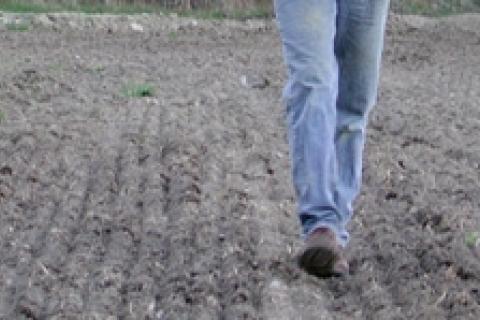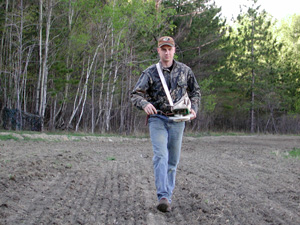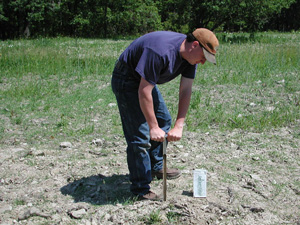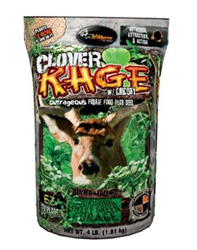
Seems like everyone is planting food plots these days; and for good reason. Wildlife of all kind benefit from them and they make for great deer hunting. Food plotters spend endless hours pouring over seed catalogs in hopes of finding the perfect food plot forage, unfortunately they don't spend nearly as much time thinking about the soil they are going to plant in.
 |
| A hand-crank seeder does a nice job of spreading seed, especially on a well-prepared seedbed like this one. |
Savvy food plotters know the better the soil, the better the plot. They spend plenty of time looking for just the right spot to plant their plots. Trouble is, most of the good soil is tied up growing ag crops and most food plotters are working with what is commonly termed "recreation property" or the land farmers gave up on 100 years ago. But, this doesn't mean you can't find good soil to plant in you just have to be aware of a few things.
Location, Location, Location
Finding the right place to park your food plot is just about the most important thing you can do. Start with existing old fields and clearings. Open spaces may have been farmed before and if they have they just may contain some good dirt. Look for areas of dense existing vegetation. If a spot can grow good weeds, chances are it can grow good food plots. Beginners in the game tend to choose areas with sparse vegetation under the assumption that they will be easier to clear and plant. Stay away from open places with sparse ground cover. It could be a dry spot, maybe a spot that is too wet for most plants to grow, whatever the reason if it is not populated with plants now, and chances are it will not support them going forward.
Let the Sun Shine In
You will also be needing some sunshine (a minimum of 4 hours direct sun per day) and some moisture for your food plots but if there are already lush plants growing there we can assume that is taken care of. Bottom line, don't plant in the shade and stay away from super dry locations like some sands, rock outcroppings and areas that get hit with scorching temps and high winds. Of course stay away from excessively wet locations as well. Your best indicator is always the native vegetation growing there. If the area is growing bog plants, it is too wet, no plants at all, too dry, or too dark or something else. Plant where plants are already growing and you should be OK.
Can You Hunt It?
Once you locate a possible planting spot take a good hard look at the surrounding terrain to see if the site is huntable. Is there a nice dark pine or two nearby to hide a tree stand in? Will the site work well with the prevailing winds during hunting season? Will deer move to the plot naturally or will they have to go out of their way to use the plot? All are important questions and all should be answered in the affirmative. If the answer is "no" to any of the above you may need to develop another location for your food plot. Or, you might leave it as is for a feeding or attracting plot with no intentions of hunting it.
Soil Test Mandatory
I know you have heard it before, but once you know where you want to plant, you have to check your soil's pH and fertility. Dig down a few inches below the surface and take a few samples from around the plot. Mix them in a clean plastic bucket and dump some in a plastic sandwich bag. Take it to your local feed and seed store, ag extension office, or send it to the Whitetail Institute for analysis. You will have the analysis in a few days and you will know whether or not you need to amend your soil with lime and what mixture of fertilizer to use. This analysis will determine your game plan going forward and following it will be the difference between success and failure.
You add lime to adjust the soil pH; most of the time you will be trying to "sweeten" up acidic soil. A reading of 7 is perfect pH for most food plot forages but most will do fine in anything over 6 on the scale. Anything below 6 (acid) should get a healthy dose of lime (which is very "sweet") to begin raising the pH. Use quick acting lime if you will be planting this year.
 |
| A soil analysis is a must; a garden trowel and plastic bucket are every bit as good as this professional corer. |
Raising the pH of soil will allow nutrients to be released to plants as acidic soil "binds" nutrients and makes them inaccessible to plants. Spread a bag of fertilizer on acidic ( 4.5 -5.9) soil and very little of the fertilizer will be taken up by the plants. Spread the same bag on "sweet' (6.0-7) soil and most if not all of the fertilizer will be used by the plants. The results are truly astounding. Lush green fast growing plants vs. scraggly undernourished weed infested fields.
If you have had a soil test done and told the lab what you want to plant in the plot you should have a fertilizer recommendation to work with. Follow the recommendation as closely as possible when purchasing fertilizer but don't get all worked up if you can't find the exact fertilizer they call for. Fertilizers are comprised of 3 critical elements: nitrogen, phosphorus, and potassium or (N,P,K). Those are the three numbers you find on fertilizer bags (10-10-10) (0-20-15) or some other numerical combination indicate the proportion of each element found in the bag. Most food plot seed bags come with fertilizer recommendations which should be followed as closely as possible.
Get Down & Dirty
Once you have your location all set you need to go about preparing a seed bed. Sorry, you can't throw some seeds on the ground, walk away and come back in 3 months to a lush food plot. Seeds have to make contact with dirt in order to grow; so that's your next mission. If you are doing a hidden postage stamp sized plot you can grab your old garden rake and stir up some dirt. If you are looking at up to an acre you will probably need an ATV pulling some type of cultivation tool. Over an acre is pretty much tractor talk with real farm implements. How you get to the dirt is pretty much up to you but you need bare dirt to grow a food plot.
Herbicides come in real handy when you are looking to get down and dirty. Roundup or Arrest by the Whitetail Institute applied to growing plants will generally kill them in a week or so and allow your work up a nice seed bed in the spaces vacated by the dead plants. Two early to mid season applications of a herbicide paced a about a month apart will generally kill most of the weeds and grasses growing in a weed field or old food plot.
It is much easier to "find dirt" under dead plants than chop your way through living material. A good hand sprayer is one of the best tools a food plotter can own.
Sewing Seeds
Once you have gotten your dirt prepared for seed (relatively smooth and satiny with few clogs and no living material) it is time to plant. Food plot seeds like clover and chicory are tiny and vulnerable if buried too deeply. A 1/8th if an inch deep is about right. That means you spread the seed evenly before a rain and walk away confident that the rain will help the seed make contact with the ground or you spread the seed evenly and roll it down or use a cultipacker to guarantee good seed to soil contact. Seed lying on top of a grass matt will not grow. Neither will seed buried 3 inches in the ground or seeds suspended in rough cracks or crevices with poor soil contact. Smooth satiny seed beds make for good seed to soil contact.
 |
| The author prefers a perennial mix of clover-chicory from the Whitetail Institute. |
The wrong way to spread seed is the way it is done in the movies; one handful at a time, cast with the wind. It may work for Sally Fields but it won't for you. For about 8 bucks you can by a hand crank "whirligig" designed for grass seed that will do just fine. Always follow manufacturer's recommendations when spreading seed; if they say one bag per acre that's it, one bag per acre. Too many plants crammed into too small a space is a formula for failure. The crowded plants look good for a while but crowded plants are the first to fail when the growing gets tough and they seldom grow to maturity.
What to Plant
Choosing plants used to be pretty easy: clover or clover. Not any more. What with the proliferation of food plot seed companies everyone has their own magic bean so to speak. Our day in day out favorite perennial (comes back every year) mix is a clover-chicory blend from the Whitetail Institute. When it comes to annuals (replant every year) we like a combo of brassicas and a grain like oats or rye. Actually I could write books about food plot blends and the market is chock full of good ones. Your best bet is to by pre mixed blends by brand name companies like the Whitetail Institute. Bass Pro Shops carries a complete line of food plot forages.
Don't try to mix your own. Chances are you will be working with cattle forages and you won't have the skill or background to mix your own. Neither will your local farmer. Leave the blending to the pros and buy only name brands.
A good food plot is at thing of beauty and a boon to all types of wildlife. Food plots provide outstanding nutrition to whitetails and are great places to view and hunt deer. Hunters everywhere have discovered this and if you haven't given them a try this just may be the year to take the plunge. For more information on planting food plots, pick up a copy of Grow 'Em Right at Bass Pro Shops.
- 4366 views

